
Queen Victoria's family tree Family Tree
It is not known whether Queen Victoria was a carrier of haemophilia A or B, which are caused by deficiency of clotting Factors VIII and IX respectively. Both play a critical role in the intrinsic pathway activation of prothrombin to thrombin, which then converts fibrinogen to fibrin to form the structural framework of clotted blood.

Hemophilia All You Need to Know About Hemophilia Page 10 of 16 Left Side Pains
However, the events caused by hemophilia entering into the Russian royal family had a far great impact on their country. Czar Nikolacvich of Russia married Queen Victoria's granddaughter, Princess Alix, in 1894, (Stevens 27). Together the couple had their first son, Alexis, who was quickly diagnosed with hemophilia, (Hermans 845).

Photographic family tree of Queen Victoria afflicted with haemophilia... Download Scientific
• Mothers of one son with hemophilia who have no other family members who either have or are carriers of hemophilia • Sisters, mothers, maternal grandmothers, aunts, nieces, and female cousins of carriers Pedigree analysis is important to detect obligatory carriers. The family tree of Queen Victoria of England, for example, illustrates how.

Queen Victoria and her family, and a pedigree showing the transmission of hemophilia in the
Queen Victoria's Gene: Haemophilia and the Royal Family. D M Potts, W T W Potts Alan Sutton, pounds sterling18.99, pp 160 ISBN 0 7509 0868 8. The death of Princess Charlotte in 1817 was mourned by the whole nation. She died at the age of 21, shortly after delivering a stillborn male infant.
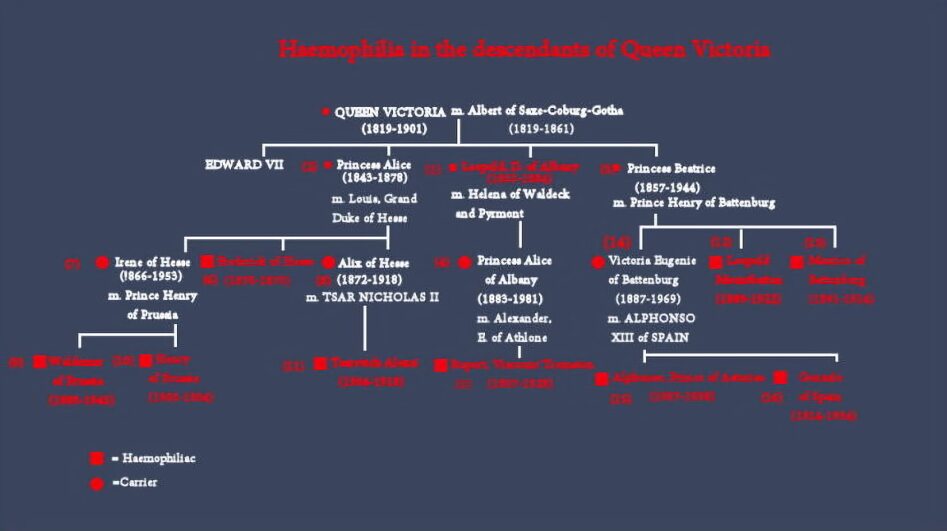
Haemophilia in the Descendants of Queen Victoria
Highly misunderstood in Queen Victoria's day, hemophilia not only altered the trajectory of the queen's own motherhood but heavily influenced the course of European history in the decades following her death. When Victoria was born in 1819, there were no outward signs of hemophilia in the British royal family.
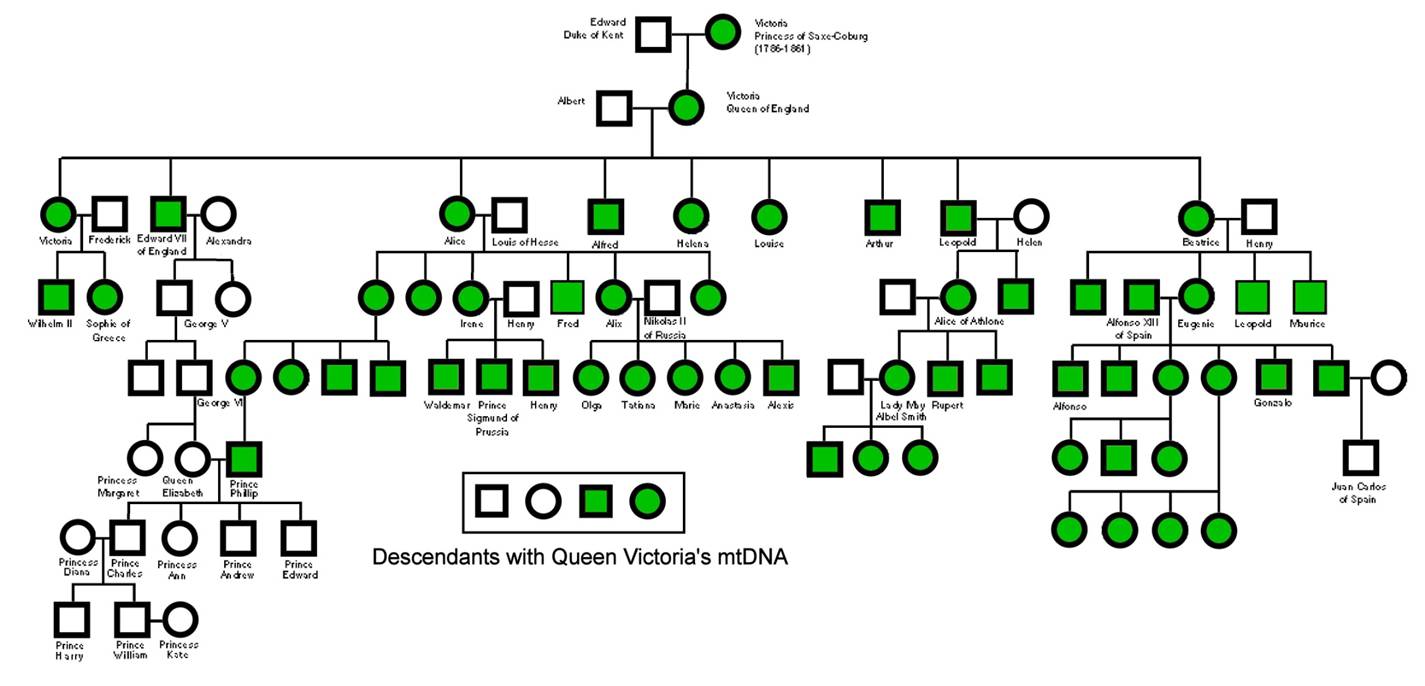
mtDNA in descendants of Queen Victoria
Queen Victoria's youngest child, Beatrice, passed hemophilia to the Spanish royal family. Beatrice married Prince Henry of Battenberg, then passed the bleeding disorder on to at least two of their four children.

Photographic family tree of Queen Victoria afflicted with haemophilia... Download Scientific
Born on May 24, 1819, Alexandrina Victoria was quite literally born to be queen. The daughter of Prince Edward, the Duke of Kent—fourth son of King George III—and German widow Princess Victoire.

Below is a partial pedigree of hemophilia in the British Royal Family descended from Queen
to share - to copy, distribute and transmit the work. to remix - to adapt the work. Under the following conditions: attribution - You must give appropriate credit, provide a link to the license, and indicate if changes were made.

Queen Victoria Hemophilia Pedigree Chart
Children of Queen Victoria and Prince Albert. Victoria Adelaide Mary, Princess Royal (November 21, 1840-August 5, 1901) married Frederick III of Germany (1831-1888) Kaiser Wilhelm II, German Emperor (1859-1941, emperor 1888-1919), married Augusta Viktoria of Schleswig-Holstein and Hermine Reuss of Greiz. Prince Henry of Prussia (1862.
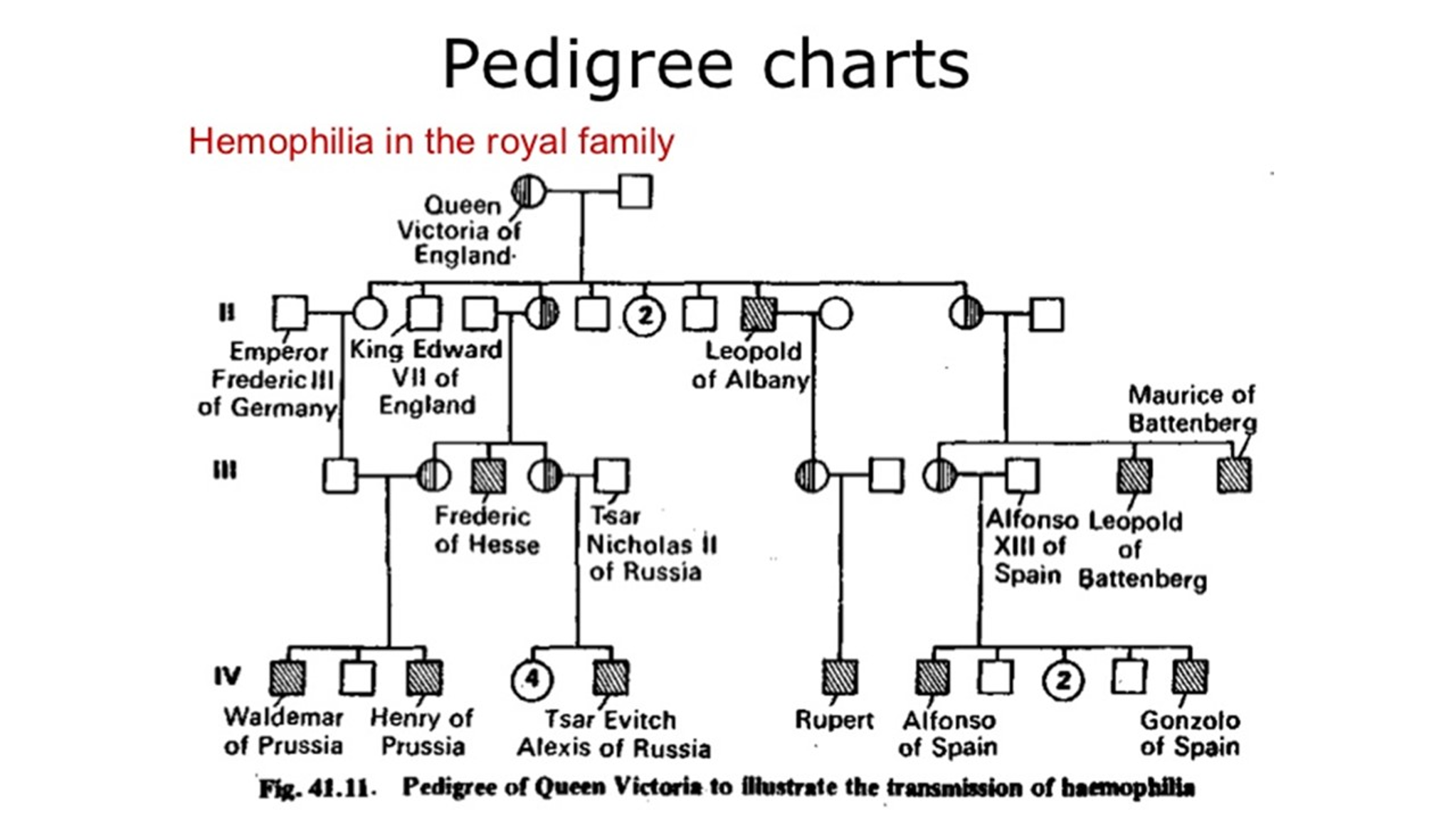
Hemophilia Pedigree Chart Royal Family
Queen Victoria of England, who ruled from 1837-1901, is believed to have been the carrier of hemophilia B, or factor IX deficiency. She passed the trait on to three of her nine children. Her son Leopold died of a hemorrhage after a fall when he was 30. Her daughters Alice and Beatrice passed it on to several of their children.
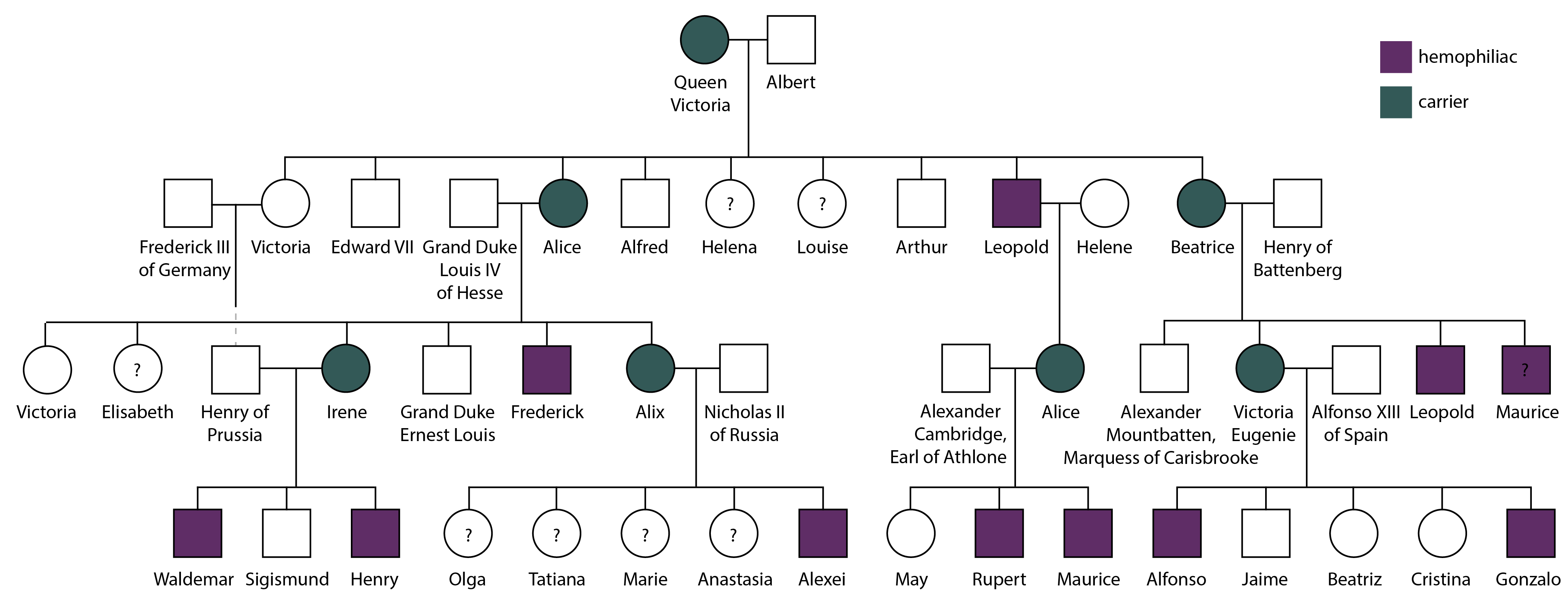
HEMOPHILIA pedigree of Queen Victoria and Prince Albert. Pedigree chart, Queen victoria
On the 13th of August 1934 a scion of one of Europe's foremost royal families died prematurely in Krumpendorf in Austria. Infante Gonzalo was the son of the.
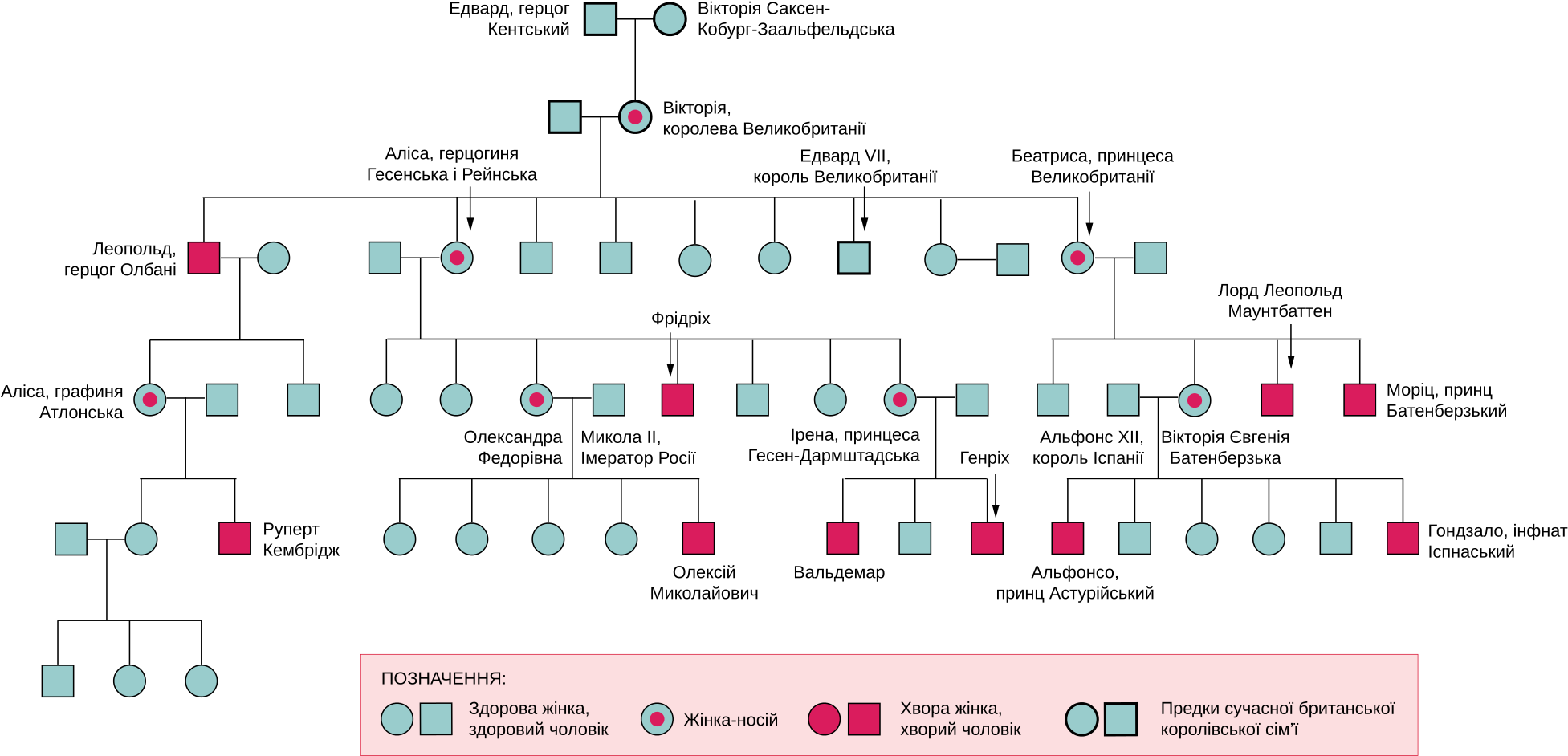
Download Open Haemophilia Queen Victoria Family Tree PNG Image with No Background
Queen Victoria and many of her descendants carried what was once called "Royal disease"—now known as hemophilia, a blood clotting disorder. But it has remained unknown precisely what variety.

Misteri Penyakit Hemofilia Pada Keturunan Ratu Victoria
Victoria's appears to have been a spontaneous or de novo mutation, most likely inherited from one of her parents, and she is usually considered the source of the disease in modern cases of haemophilia among her descendants.

4. Haemophilia And Royal Families Queen victoria family tree, Victoria family tree, Queen
Case Study: Hemophilia in Queen Victoria Family. Hemophilia has also been known as Royal disease because many members of family of Queen Victoria are affected by this disorder. As it is X linked recessive disorder, majorly males of the family are affected as shown in the family tree.

Queen Victoria's family tree with Hemophilia markers Queen victoria family, Queen
As a result, haemophilia presented itself in various royal bloodlines throughout Europe including Spain, Russia, and Prussia. Some of these royal families took precautions to secure their bloodline, but others were not so careful. Queen Victoria, c 1870. Despite warnings from King Edward VII and the Spanish Ambassador, King Alfonso XIII of.

Hemophilia Pedigree Chart Royal Family
appearance of hemophilia as it popped up in Spain, Russia, and Prussia by looking at the family tree (see large chart at end of case). ! 1. First, let's take a look at Queen Victoria's son Leopold's family. His daughter, Alice of Athlone, had one hemophilic son (Rupert) and two other children—a boy and a girl—whose status is unknown.